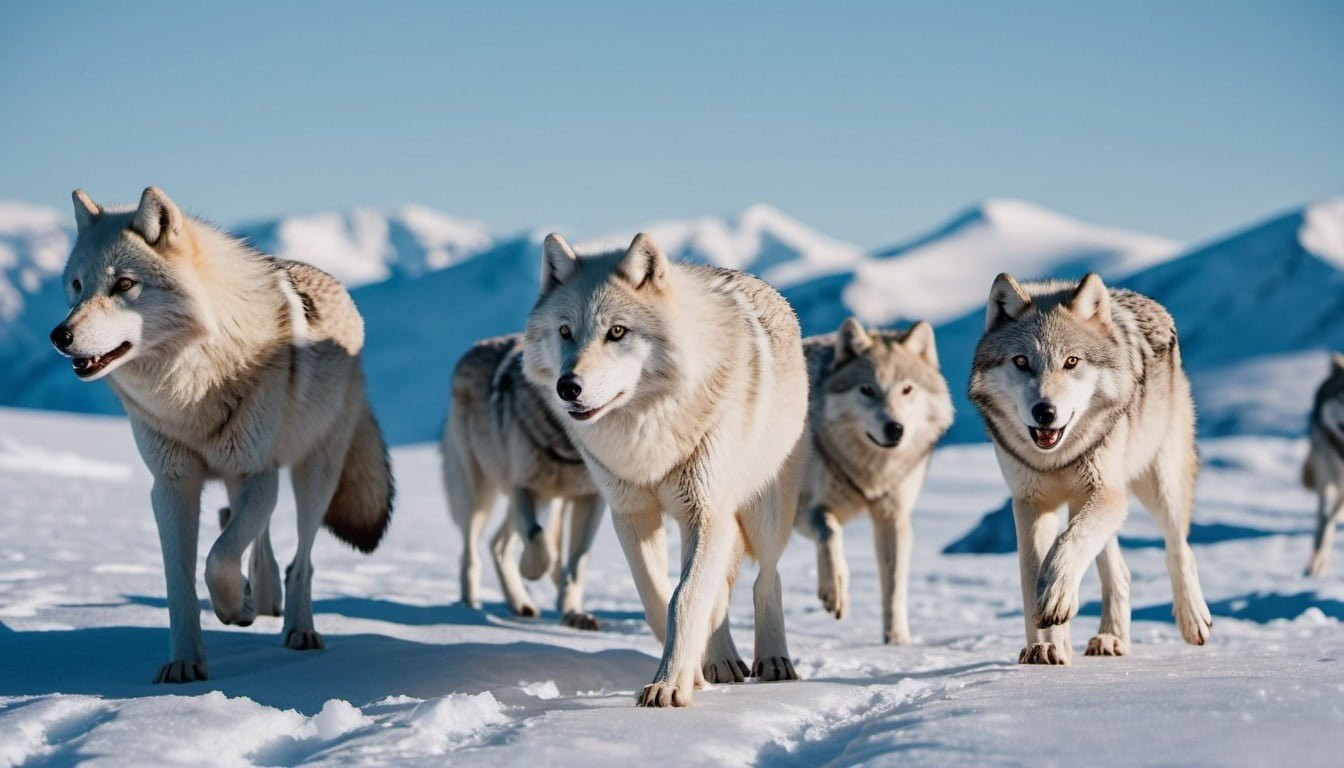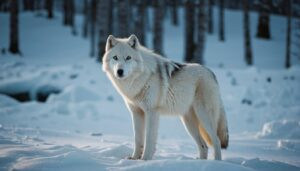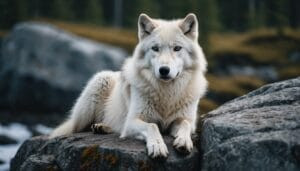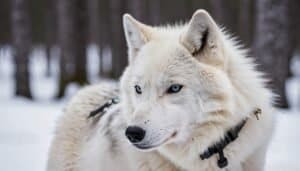Introduction
Research on Arctic wolf migration patterns is crucial for understanding these majestic animals’ behavior and the broader ecological impacts in the Arctic region
This article delves into their annual migration cycles, factors influencing their movements, and recent findings. It also explores the advanced technologies used in tracking, the significant impact of climate change, and the challenges researchers face
Additionally, we’ll highlight leading organizations and key contributors in this field
Understanding Arctic Wolf Migration
Research into the migration patterns of Arctic wolves provides insight into their behavior and how they interact with their environment. Migration is essential for Arctic wolves, enabling them to follow prey and avoid harsh weather conditions
In this section, we will explore their annual migration patterns, factors influencing these movements, and variations observed in their routes and seasons
Annual Migration Patterns
Arctic wolves, primarily found in the Canadian Arctic and Greenland, exhibit distinct annual migration patterns. These wolves travel great distances to find food, primarily caribou and muskoxen, which themselves are migratory
During the winter months, Arctic wolves migrate southward, following their prey to areas with less severe weather and more abundant food sources. In the summer, they return north to their breeding grounds where they raise their young
Migration is influenced by the need to maintain a balance between energy expenditure and food intake. By moving to areas with higher prey density, Arctic wolves can reduce the effort required to hunt, thus conserving energy. This cyclical migration ensures that they remain in regions where they can sustain themselves throughout the year
Factors Influencing Migration
Several factors influence Arctic wolf migration. The availability of prey is the primary driver, as wolves need to follow the movements of caribou and other large herbivores to survive
Climate conditions also play a crucial role; wolves tend to move away from extreme weather conditions that make hunting difficult and dangerous
Additionally, the physical condition of the pack members can affect migration. Packs with young pups or elderly members may alter their routes or travel distances to accommodate these individuals. Human activities, such as oil exploration and mining, can disrupt traditional migration routes, forcing wolves to adapt to new pathways
Migration Routes
The migration routes of Arctic wolves are typically aligned with those of their prey. These routes can span hundreds of miles and vary based on the time of year and prey movement. Researchers have identified specific corridors that are frequently used by wolves, providing vital information for conservation efforts
During migration, wolves rely on their keen sense of smell and memory of the landscape to navigate. They often travel in family groups, maintaining social bonds and improving hunting efficiency
The routes taken by Arctic wolves are influenced by the availability of resources along the way, including water sources and resting places
Seasonal Variations
Seasonal variations significantly impact Arctic wolf migration. In the spring and summer, when prey is abundant and dispersed, wolves may travel shorter distances and spend more time in one area to raise their pups. The warmer weather and increased daylight also facilitate longer hunting periods
In contrast, during the fall and winter, prey animals congregate in specific areas, prompting wolves to migrate longer distances to find them. The harsh winter conditions, such as deep snow and ice, can pose challenges, but the wolves’ thick fur and physiological adaptations help them endure the cold
Understanding these seasonal variations helps researchers predict migration patterns and develop strategies to protect both wolves and their habitats. By studying the timing and routes of migrations, conservationists can mitigate the impact of human activities and climate change on these crucial movements
Research Methods and Technologies
Studying Arctic wolf migration requires sophisticated methods and technologies to accurately track and analyze their movements. Researchers utilize various tools to gather data on wolf behavior, migration routes, and the environmental factors influencing these patterns
This section explores the key technologies employed and the data analysis techniques used in this research
GPS and Satellite Tracking
One of the primary technologies used in studying Arctic wolf migration is GPS (Global Positioning System) and satellite tracking. Researchers fit wolves with collars equipped with GPS devices that transmit location data at regular intervals. This technology allows scientists to monitor the real-time movements of wolves over extended periods and across vast distances
GPS tracking provides precise data on the wolves’ migration routes, travel speeds, and resting locations. It also helps identify critical habitats and migration corridors that are essential for the wolves’ survival. The collars are designed to be lightweight and durable, minimizing any impact on the wolves’ natural behavior
Satellite tracking complements GPS technology by providing a broader overview of the wolves’ movements and environmental conditions. Satellites can capture images and data on weather patterns, vegetation cover, and prey availability, offering a comprehensive understanding of the factors influencing migration
Data Analysis Techniques
Once data is collected through GPS and satellite tracking, researchers employ various data analysis techniques to interpret the information
Geographic Information Systems (GIS) are widely used to visualize and analyze spatial data. GIS allows scientists to create detailed maps of migration routes, identify patterns, and assess changes over time
Statistical modeling is another crucial tool in migration research. By applying statistical techniques, researchers can predict future migration patterns, assess the impact of environmental changes, and evaluate the effectiveness of conservation strategies. Models can incorporate multiple variables, such as prey density, weather conditions, and human activities, to provide a holistic view of migration dynamics
Machine learning algorithms are increasingly being used to analyze large datasets generated by tracking technologies. These algorithms can identify complex patterns and relationships that may not be apparent through traditional analysis methods
For example, machine learning can help detect subtle shifts in migration routes due to climate change or human disturbances
Observational Studies and Field Research
In addition to technological methods, observational studies and field research play a vital role in understanding Arctic wolf migration. Researchers conduct field surveys to collect data on wolf behavior, pack dynamics, and interactions with prey. These studies provide valuable insights that complement the data obtained through tracking technologies
Field research often involves direct observation of wolves in their natural habitats. Scientists may use binoculars, cameras, and drones to monitor wolf packs and record their activities. By observing wolves in different seasons and environments, researchers can gain a deeper understanding of the factors driving migration and how wolves adapt to changing conditions
Collaborative efforts with indigenous communities also enhance research on Arctic wolf migration. Indigenous knowledge and traditional ecological practices provide valuable perspectives on wolf behavior and migration patterns. By integrating this knowledge with scientific research, a more comprehensive understanding of Arctic wolf ecology can be achieved
Overall, the combination of advanced technologies and traditional field research methods enables scientists to study Arctic wolf migration with greater precision and depth. These efforts contribute to conservation strategies aimed at preserving Arctic wolf populations and their habitats in the face of environmental challenges
Impact of Climate Change on Migration
Climate change significantly affects Arctic wolf migration patterns, as it alters the wolves’ habitat, prey availability, and overall ecosystem dynamics. This section examines how changes in the Arctic environment impact wolf migration, focusing on habitat alterations and the effects on prey populations
Changes in Habitat
Climate change is causing profound shifts in the Arctic landscape, including melting ice, thawing permafrost, and changes in vegetation. These alterations directly impact the habitats that Arctic wolves depend on for survival
As the Arctic warms, traditional hunting grounds and denning sites may become less accessible or disappear altogether
The loss of sea ice is particularly concerning for Arctic wolves. In regions where wolves rely on ice to travel and hunt marine mammals, the reduction of ice cover forces them to adapt to new environments. This can lead to increased competition with other predators, such as polar bears, and necessitates longer and more arduous migrations to find suitable habitats
Vegetation changes also influence wolf migration. Warming temperatures are causing shifts in plant communities, affecting the distribution and abundance of prey species. As the tundra transitions to shrubland, the availability of cover and food resources for prey changes, thereby altering the wolves’ hunting strategies and migration routes
Effects on Prey Availability
Prey availability is a critical factor in Arctic wolf migration, and climate change has significant implications for the populations of key prey species like caribou and muskoxen. These herbivores are highly sensitive to environmental changes, and their movements and population dynamics are closely tied to climatic conditions
Warmer temperatures and altered precipitation patterns can impact the timing and extent of caribou migrations. Changes in snow and ice cover affect caribou’s ability to access grazing areas, forcing them to adjust their migratory routes
As caribou shift their patterns, Arctic wolves must also adapt to continue following their primary food source
Additionally, climate change can influence the reproductive success and survival rates of prey species. Harsh winter conditions, such as ice storms that create crusted snow, can impede the ability of caribou and muskoxen to forage, leading to lower survival rates
Reduced prey populations result in increased competition among wolves and may necessitate longer migrations to find sufficient food
The timing of seasonal events, such as calving periods for caribou, is also affected by climate change. Mismatches between the peak availability of vulnerable young prey and the wolves’ need to feed their own young can lead to decreased survival rates for wolf pups
These challenges underscore the complex interplay between climate change, prey dynamics, and wolf migration
Adaptation and Resilience
Despite the challenges posed by climate change, Arctic wolves exhibit remarkable adaptability and resilience. They can adjust their hunting strategies, modify migration routes, and exploit new food sources. However, the rapid pace of environmental change in the Arctic tests the limits of their adaptability
Researchers are closely monitoring how Arctic wolves respond to these changes, seeking to understand the long-term implications for wolf populations and the broader ecosystem. Conservation efforts aim to mitigate the impact of climate change by protecting critical habitats, reducing human-induced stressors, and promoting ecosystem resilience
Studies on the genetic diversity and health of Arctic wolf populations also provide insights into their capacity to adapt to changing conditions. Maintaining genetic diversity is crucial for the long-term survival of the species, as it enhances the ability of wolves to cope with environmental fluctuations
Challenges in Studying Arctic Wolf Migration
Researching Arctic wolf migration presents numerous challenges due to the harsh environment, logistical difficulties, and limitations of current tracking technologies. This section explores the primary obstacles faced by researchers, including the extreme Arctic conditions and the technical challenges associated with tracking these elusive predators
Harsh Arctic Conditions
One of the most significant challenges in studying Arctic wolf migration is the extreme and often unpredictable weather conditions. The Arctic environment is characterized by severe cold, strong winds, and extended periods of darkness during the winter months
These conditions make it difficult for researchers to conduct fieldwork and can pose significant risks to their safety
Logistical challenges include accessing remote and rugged areas where Arctic wolves live and migrate. Many of these regions are inaccessible by road, requiring researchers to use helicopters, snowmobiles, or even dog sleds to reach their study sites. The cost and complexity of organizing such expeditions can limit the frequency and duration of field studies
Moreover, the Arctic’s remoteness means that researchers must be self-sufficient, carrying all necessary supplies and equipment with them. This includes food, fuel, shelter, and medical supplies, adding to the logistical burden
The need to minimize the environmental impact of research activities also requires careful planning and adherence to strict protocols
Tracking Limitations
Tracking Arctic wolves poses unique technical challenges. While GPS and satellite collars provide valuable data, they are not without limitations. For instance, the harsh conditions can affect the performance of tracking devices
Extreme cold can drain battery life quickly, reducing the duration over which data can be collected. Snow and ice can also interfere with signal transmission, leading to gaps in data
Additionally, fitting wolves with tracking collars is a complex task. It requires capturing and sedating the animals, which can be stressful for the wolves and dangerous for the researchers. The collars must be designed to minimize discomfort and avoid impacting the wolves’ natural behavior
Despite advances in collar technology, ensuring that the devices remain functional and securely attached over long periods remains a challenge
Another limitation is the sheer vastness of the Arctic. Wolves can travel hundreds of miles, often moving in areas that are beyond the range of tracking devices or where satellite coverage is sparse. This can result in incomplete data, making it difficult to form a comprehensive picture of migration patterns
Data Interpretation and Integration
Interpreting the data collected from tracking devices involves significant challenges as well. The vast amounts of data generated require sophisticated analysis techniques to identify meaningful patterns and trends. Researchers must filter out noise and account for variables such as weather conditions, prey movements, and human activities that can influence migration
Integrating data from multiple sources, including GPS collars, satellite imagery, and field observations, is essential for a holistic understanding of wolf migration. However, this requires advanced computational tools and expertise in data analysis
Discrepancies between different data sources can complicate the interpretation process and necessitate cross-validation to ensure accuracy
Human Impact and Ethical Considerations
Human activities, such as industrial development, tourism, and climate change, also pose challenges to studying Arctic wolf migration. These activities can disrupt traditional migration routes and alter the natural behavior of wolves. Researchers must account for these impacts when designing studies and interpreting data
Ethical considerations are paramount in wildlife research. Ensuring the welfare of the wolves and minimizing disturbance is a priority. This requires the development and implementation of best practices for capturing, handling, and monitoring wolves
Additionally, researchers must navigate the ethical implications of their findings, particularly when recommending conservation measures that may affect local communities and industries
Leading Organizations and Researchers
Research on Arctic wolf migration is driven by a collaborative effort among various organizations and researchers dedicated to understanding and preserving these remarkable animals
This section highlights major research institutions, notable researchers, and their significant contributions to the study of Arctic wolf migration
Major Research Institutions
Several institutions are at the forefront of Arctic wolf migration research, utilizing advanced technologies and interdisciplinary approaches to study these elusive predators:
The Wildlife Conservation Society (WCS): The WCS is a leading global organization dedicated to the conservation of wildlife and wild places
Their Arctic Beringia Program focuses on understanding the ecology and behavior of Arctic species, including wolves. WCS researchers use GPS collars and satellite tracking to monitor wolf movements and assess the impact of environmental changes on their migration patterns
The University of Alberta: The University of Alberta’s Department of Biological Sciences conducts extensive research on Arctic wildlife, including wolves
Researchers from this institution have published numerous studies on wolf ecology, behavior, and migration. Their work often involves field studies in remote Arctic regions and collaborations with indigenous communities
The Norwegian Institute for Nature Research (NINA): NINA is a leading research institution in Norway focused on biodiversity and ecosystem studies
Their Arctic research includes studies on predator-prey dynamics and the impact of climate change on Arctic species. NINA’s work provides valuable insights into the migration patterns of Arctic wolves and their interactions with other species
Notable Researchers and Their Contributions
Several researchers have made significant contributions to the understanding of Arctic wolf migration through their innovative studies and publications:
Dr. David Mech: Dr. David Mech is a renowned wolf biologist and senior research scientist with the U.S. Geological Survey
With over five decades of research experience, Dr. Mech has authored numerous papers and books on wolf ecology and behavior. His studies on wolf pack dynamics and migration have been instrumental in advancing the field
Dr. L. David Mech and Dr. Luigi Boitani: Co-authors of the influential book “Wolves: Behavior, Ecology, and Conservation,” Dr. Mech and Dr. Boitani have significantly shaped the understanding of wolf ecology
Their collaborative work has provided comprehensive insights into wolf behavior, including migration patterns, and has guided conservation strategies worldwide
Dr. Paul Paquet: Dr. Paul Paquet is a prominent ecologist and conservation biologist known for his extensive research on wolves and other large carnivores
His work with the Raincoast Conservation Foundation and other organizations has focused on the ecological role of wolves and the challenges they face in changing environments. Dr. Paquet’s studies on wolf migration have highlighted the importance of connectivity between habitats
Dr. Linda Gormezano: Dr. Linda Gormezano’s research on Arctic predators, including wolves, has contributed valuable knowledge about their adaptations to the rapidly changing Arctic environment
Her work involves the use of remote sensing technologies to study predator-prey interactions and migration patterns, providing critical data for conservation efforts
Collaborative Efforts and Indigenous Knowledge
Collaboration between researchers and indigenous communities is essential for a comprehensive understanding of Arctic wolf migration. Indigenous knowledge and traditional ecological practices offer unique perspectives on wolf behavior and migration routes:
Inuit Tapiriit Kanatami (ITK): ITK is a national organization representing Inuit communities in Canada
Their involvement in wildlife research, including Arctic wolves, helps integrate traditional knowledge with scientific studies. Collaborative projects between ITK and research institutions enhance the understanding of how wolves navigate and adapt to their environment
Arctic Council’s Conservation of Arctic Flora and Fauna (CAFF): CAFF is a working group of the Arctic Council dedicated to conserving Arctic biodiversity
Their efforts include monitoring and assessing the status of Arctic species, including wolves. CAFF’s collaborative approach involves indigenous knowledge, scientific research, and policy recommendations to protect Arctic wildlife
Conclusion
Research on Arctic wolf migration is crucial for understanding the intricate dynamics of these magnificent creatures and the Arctic ecosystems they inhabit. By studying their annual migration patterns, researchers can gain insights into how Arctic wolves adapt to the harsh and changing environments
Advanced technologies like GPS and satellite tracking, combined with field observations, provide comprehensive data that enhance our knowledge of wolf behavior and migration routes
Climate change poses significant challenges to Arctic wolf migration, altering habitats and prey availability. Understanding these impacts is vital for developing effective conservation strategies to ensure the survival of Arctic wolves in a rapidly changing world
The collaborative efforts of major research institutions, notable scientists, and indigenous communities are instrumental in advancing this field of study. These partnerships integrate scientific research with traditional ecological knowledge, offering a holistic approach to studying and protecting Arctic wolves
Despite the numerous challenges faced in studying Arctic wolf migration, including harsh conditions and tracking limitations, ongoing research continues to reveal valuable information. The contributions of organizations like the Wildlife Conservation Society, the University of Alberta, and the Norwegian Institute for Nature Research, along with the work of distinguished researchers, play a pivotal role in this endeavor
In conclusion, the study of Arctic wolf migration patterns is a testament to the resilience and adaptability of these animals. Continued research and conservation efforts are essential to protect Arctic wolves and maintain the ecological balance of the Arctic region
By understanding their migration, we can better appreciate the complexities of the Arctic ecosystem and the importance of preserving it for future generations










